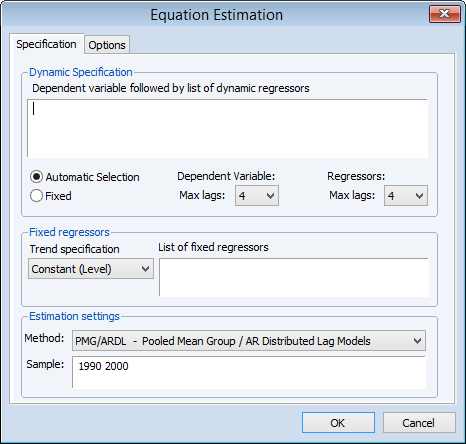

The term “autoregressive” shows that along with getting explained by the x t’, y t also gets explained by its own lag also. ARDL modelĪn ARDL (Autoregressive-distributed lag) is parsimonious infinite lag distributed model. However, ARDL model addresses the distributed lag problem more efficiently than these models. In order to determine, the dynamic influence of a variable on other variables, there occurs multiple distributed lag models such as polynomial, geometric and other distributed lag models in econometrics.

Y t =f( X t, X t-1, X t-2,……) , where, t-i represents the number of lags. The below function represents the lag effect of a variable on other variables and its own lags as well Thus, the long and short run behavioral consequences of a variable on other variable bring the role of distributed lag model in the scenario. Not only macroeconomic variables, other variables such as loss or profit earned by a firm in a year can affect the brand image of an organization over the period.įor instance: effect of a profit making decision taken by an organization in a year may have influence on the profit and brand image of an organization in the time t along with future periods such as t + 1, t + 2 and so on. This change in a variable is not what reflects immediately, but it distributes over future periods. In an economy, change in any economic variables may bring change in another economic variables beyond the time. ISSN 0277-6715.Auto regressive Distributed Lag Models (ARDL) model plays a vital role when comes a need to analyze a economic scenario. ^ Gasparrini, A Armstrong, B Kenward, M G ()."Bayesian distributed lag models: estimating effects of particulate matter air pollution on daily mortality". "The temporal pattern of mortality responses to air pollution: a multicity assessment of mortality displacement". ^ Zanobetti, Antonella Schwartz, Joel Samoli, Evi Gryparis, Alexandros Touloumi, Giota Atkinson, Richard Le Tertre, Alain Bobros, Janos Celko, Martin Goren, Ayana Forsberg, Bertil (January 2002).Journal of the American Statistical Association. "A modification of the Almon distributed lag". ^ Speaker, Paul J., Mitchell, Douglas W., and Gelles, Gregory M., "Geometric combination lags as flexible infinite distributed lag estimators," Journal of Economic Dynamics and Control 13, 1989, 171-185.^ Gelles, Gregory M., and Mitchell, Douglas W., "An approximation theorem for the polynomial inverse lag," Economics Letters 30, 1989, 129-132.

AUTOREGRESSIVE DISTRIBUTED LAG EVIEWS SERIES
Multivariate Tests For Time Series Models. The distributed lag model concept was first to apply to longitudinal cohort research by Hsu in 2015, studying the relationship between PM2.5 and child asthma, and more complicated distributed lag method aimed to accommodate longitudinal cohort research analysis such as Bayesian Distributed Lag Interaction Model by Wilson have been subsequently developed to answer similar research questions. Gasparrini introduces a more flexible statistical models in 2010 that are flexible enough to describe additional time dimensions of the exposure-response relationship, and develop the family of distributed lag non-linear models (DLNM), a modeling framework that can simultaneously represent non-linear exposure-response dependencies and delayed effects. The Bayesian version of the model was suggested by Welty in 2007. While time series studies have been established in epidemiology for a long time, the concept has been introduced into health-related studies in 2002 by Zanobetti and Schwartz. The gamma lag and the rational lag are other infinite distributed lag structures.ĭistributed lag model in health studies ĭistributed lag models are also used in health studies as a method incorporating time-series concept into time-to-event analysis or sensitive window analysis. Y t = a + w 0 x t + w 1 x t − 1 + w 2 x t − 2 +. The starting point for a distributed lag model is an assumed structure of the form In statistics and econometrics, a distributed lag model is a model for time series data in which a regression equation is used to predict current values of a dependent variable based on both the current values of an explanatory variable and the lagged (past period) values of this explanatory variable.


 0 kommentar(er)
0 kommentar(er)
